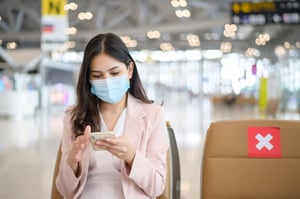What is the New Normal in B2B Travel?
As more sectors open their doors, it's crucial to understand what "business as usual" means.
To improve the travel outlook in 2021, travel professionals continue to utilize the following best practices:
- Occupant restrictions to reduce possible contamination.
- Proper health screening for staff, visitors/occupants, travelers.
- Proper sanitization measures.
Following all necessary staff and consumer safety guidelines is essential to getting back to business. However, moving into 2021 has resulted in a deep desire to get out and hit the road once again. That means travel managers need to adopt new best practices, including:
- Keeping travel policies up to date.
- Cleaning up traveler profiles and updating the list of approved travelers (possibly rotating employees to ensure those who want to travel for work can do so).
- Improving communication between all departments to create/update policies, mitigate both company and traveler risk, and ensure the health and safety of everyone involved.
Improve Your B2B Strategy
Create a promising outlook this year with the following tips:
Appeal to Your Audience's Needs
As part of the B2B hospitality space, you've spent the last year communicating your COVID-19 safety policies, updating those policies…and then communicating them again, and again. As business travel starts to make its comeback, you need to be sure you are appealing to your audience's changing needs.
- Incentives: Major airlines could implement new travel incentives, such as unlimited flight passes for domestic travel.
- Touchless technology: Let’s face it, 2020 conditioned consumers to limited interaction with physical surfaces, from mobile payments at grocery stores to QR menus at restaurants. Hotels and resorts can prepare for visitors by appealing to their need for touchless technology, such as digital keys, touchless payments or a complete booking experience through an app.
- Hybrid hospitality could also prove to be a reliable model. As many offices go mostly or fully remote, this would encourage businesses to turn to hotels when looking for an alternative working space.
Adjust Your Hospitality Sales and Marketing Strategy
Once you've identified the best ways to meet the needs of your audience, it's time to adjust your sales and marketing strategy.
While the pandemic may not be over, restrictions are changing, allowing for more B2B travel. That means you need to adjust your strategy from reactive to proactive and incorporate changes, such as:
- Sales and education training to keep your teams up to date on new policies and practices
- Developing new sales incentives programs
- Advertising new technologies
- Deploying customer engagement strategy and activation
- Rethinking your Voice of the Customer programs and events
The goal moving forward is to become the go-to for your B2B clients. The number one driver of customer loyalty is whether or not a brand can be trusted to follow through on its promises. Show your customers you're making these changes and are ready to help them get back to business as usual.
MODIV can help you create a winning B2B strategy.
Navigating the new normal can seem like an intimidating task, especially with such an uncertain B2B travel outlook. If you're a small brand looking for guidance building your approach or a larger enterprise looking to revamp your hospitality marketing strategy, MODIV can help.
Contact the MODIV team today, and let’s get going.

